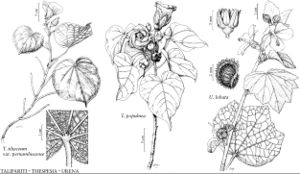Talipariti
Contr. Univ. Michigan Herb. 23: 231, figs. 1 – 5. 2001.
| Taxon | Illustrator ⠉ | |
|---|---|---|
 | Talipariti tiliaceum var. pernambucense Thespesia populnea Urena lobata | Linny Heagy Linny Heagy Linny Heagy |
Trees. Stems spreading [erect], minutely hairy [to glabrescent], not viscid. Leaves: stipules usually early-deciduous leaving annular scars, prominent, oblong, enclosing terminal bud; blade broadly ovate [orbiculate, elliptic], not dissected or parted [3-lobed], base deeply cordate [rarely cuneate], margins usually entire (sometimes obscurely crenulate or denticulate), with nectaries near base abaxially. Inflorescences axillary, solitary flowers; involucel present, bractlets persistent, connate. Flowers: calyx persistent, splitting asymmetrically, not accrescent or inflated, lobes often ribbed, triangular to ovate, not gland-dotted; corolla campanulate, yellow, fading to orange or red, sometimes drying dark greenish; staminal column included; style 5-branched from or beyond orifice or staminal column; stigmas capitate. Fruits capsules, erect, not inflated, carpels 5, subglobose or ovoid, not indurate, not fleshy, densely hairy, dehiscent. Seeds 2–many per carpel, densely hairy or seemingly glabrous. x = 40–48.
Distribution
Introduced; Fla., Mexico, West Indies, Central America, South America, Asia, Pacific Islands (especially New Guinea)
Discussion
Species 22 (1 in the flora).
Two taxa are sometimes cultivated for ornament in southern Florida: Talipariti elatum (Swartz) Fryxell and T. tiliaceum var. tiliaceum, the latter sometimes naturalized. Species of Talipariti usually are estuarine and/or littoral.
Selected References
None.